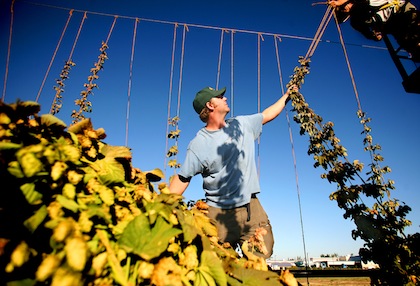Is beer not good enough? Has no one made pitch-perfect hoppy ale? I mean, what if in the evolution of brewing, we’re still at that part of the chart where we’re all just hunched over, early hominids—perhaps Austr-ale-opithecus—which is why we tend to have poor posture while perched1 on bar stools? The fact is, we’re in the relatively early stages of Humulus lupulus and there are botanical geneticists who are cultivating more perfect hops as we speak, and sip.
There’s only one species of hop but there are scores—hundreds even—of varieties grown on every continent.
In Washington’s Yakima Valley, Jason Perrault developed the new rock star, IPA-worthy hop that is Citra—high in all-important alpha acids and yields notes of pineapple and mango—at Yakima Chief Ranch, now part of the joint venture with John I. Haas, Inc. called the Hop Breeding Co. Dr. John Henning hopes his new Mt. Rainier hop—spicy with a hint of licorice—catches on; he created it at the U.S. Department of Agriculture’s Agriculture Research Service (USDA-ARS) on the Oregon State University campus in Corvallis, OR. It’s a workhorse Noble variety hop akin to grassy Hallertauer that is fairly disease resistant, tolerant to downy mildew and high-yielding with the added benefit of a desirable aroma—if you like a little licorice notes mixed with your citrus. And across the Atlantic, Dr. Peter Darby finally gained the EU Plant Variety Rights for his Sovereign hop, which exhibits classic English hop aroma like that of Fuggles—earthy with a kiss of tropical fruit—but as a dwarf variety so attractive to British hop growers. After years of breeding research and evaluation dating back to the 20th century, their efforts are just now blossoming in new beers. So imagine what you’ll be drinking starting in 2020 based on what they’re doing in their respective offices today.

Workers harvest the estate hops fields surrounding the Sierra Nevada Brewing Co. in Chico, CA. (Sierra Nevada Brewing Co.)
Is it rocket science? Not exactly. NASA recently retired the space shuttle Discovery after 30 years of exploring Earth’s low orbit so as to focus on exploring deep space, beginning with the Mars Science Laboratory and plans for the Juno spacecraft already in the works. While hop-breeding programs are, by nature, futuristic, there is way less computer hardware involved and way more dirt. Sure, there’s some software involved, but hop crosses yield seedlings that are planted in test farms and evaluated based on agronomics and aromatics. There’s no HAL 9000 in this Beer Odyssey capable of olfaction. Instead, someone like Perrault, for example, simply stands in the field, grinds some leaves between his fingers, brings them to his nose and has no clue if he’s getting a whiff of the next Simcoe (the pine-and-grapefruit scented megastar for which he holds the patent). But there’s roughly one-hundredth of a percent chance that he smells the future. And it kinda smells like citrus, or tomatoes, or possibly cheesecake.









